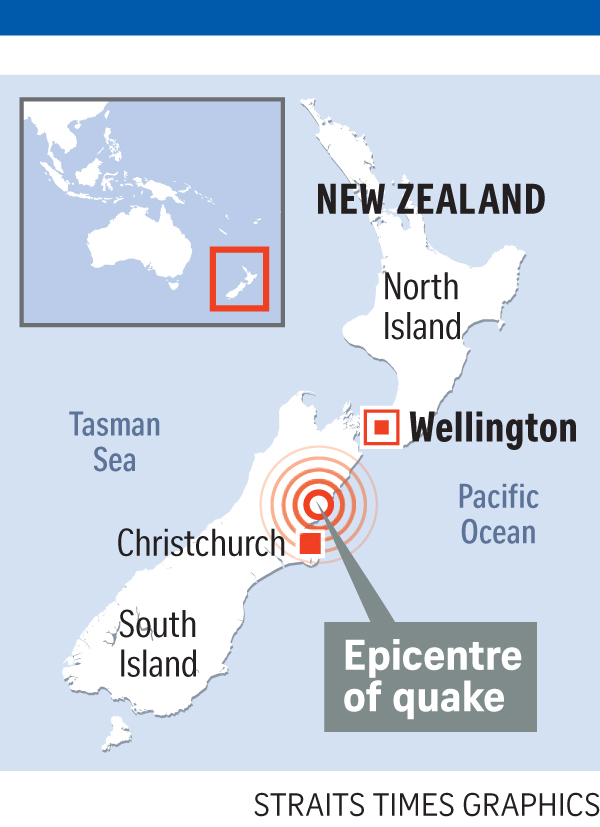CHRISTCHURCH (AFP, REUTERS) - At least two people were killed and more fatalities were feared after a powerful 7.8 earthquake struck New Zealand just after midnight Monday (Nov 14), while residents in coastal areas fled following tsunami warnings.
As dawn broke there was scant information from many rural villages in the South Island, which were isolated by landslips and fractured telephone communications as strong aftershocks continued for several hours.
Prime Minister John Key confirmed two people had died and said "we cannot rule out" that number will rise, nearly seven hours after the main quake. Police were trying to reach the scene of one fatality at a remote property 150 kilometres north of Christchurch while another person died in a historic homestead which collapsed at the nearby fishing village of Kaikoura.
"At this point we are unable to give precise details of what caused those fatalities," Key said, adding that communication problems made it difficult to get information. Helicopters were taking official workers to the worst-affected area, he said.
"As soon as we can get a much better assessment of the actual damage then we can work out the next steps."

Soon after the earthquake, tsunami warning sirens were activated in South Island coastal towns and along the east coast of the North Island, with police and emergency workers going door to door to evacuate seaside properties.
The ministry of civil defence, responsible for emergency management in New Zealand, initially warned of a "destructive tsunami" with waves of up to five metres. The first waves were measured around two metres and four hours later authorities downgraded the warning, but said risks remained.
The earthquake struck at 12.02am Monday (7.02pm Singapore time) and was 23 kilometres deep, the US Geological Survey said, putting the epicentre near the alpine tourist village of Hanmer and the rural township of Cheviot in North Canterbury, South Island.
It was one of the most powerful shakes to rock earthquake-prone New Zealand and ignited painful memories for residents in Christchurch which was devastated five years ago by a 6.3 tremor which killed 185 people.
In a brief message the Prime Minister John Key tweeted: "I hope everyone is safe after the earthquake tonight."
Anna Kaiser, a seismologist at GNS Science said a tidal signal or surge of up to 1m had been recorded in North Canterbury region of the South Island. "That's reasonably significant so people should take this seriously," she told Radio New Zealand.
It said on its website that the National Crisis Management Centre is being activated.
"We are assessing the situation with the assistance of scientific advisers and Civil Defence groups. Expect aftershocks," the statement said.
Stuff news website reported that an Interislander Ferry is unable to dock in Picton, leaving passengers and crew to sleep on board for the evening.
A passenger onboard the ship said they were due into Picton at 11.45pm local time. The decision to abort docking the ship was made following the quake.
"We were trying to dock when they earthquake hit. The ship just shuddered," she said.
The ambulance service said it did not receive any reports of quake-related injuries. However, people took to social media to report damage with goods tipped from shelves and shattered glass littering streets.
She said there was no sign of damage on her street and the power was still on, adding that she was worried about towns and villages closer to the epicentre.
"We're getting aftershocks at the moment. We're going to stock up on water supplies just in case."
Chris Hill, a fire officer in Cheviot, a coastal town near the quake's epicentre, said officials had gone door to door evacuating residents.
"Everyone seems OK here," he told RNZ. "There's a lot of debris in houses, but at this stage it doesn't look like anything too bad has happened."
Residents in Wellington said glass had fallen from buildings into the streets and hotels and apartment buildings had been evacuated. RNZ said the Wellington City Council had received multiple reports of significant damage.
The Straits Times' reader Treenah Joy, who is in Christchurch, wrote: "I stopped counting the quakes that happened afterwards because there were too many *almost every 10 mins)."
Christchurch is the biggest city on New Zealand's South Island. A 6.3 quake there in February 2011 killed 185 people and caused widespread damage.







